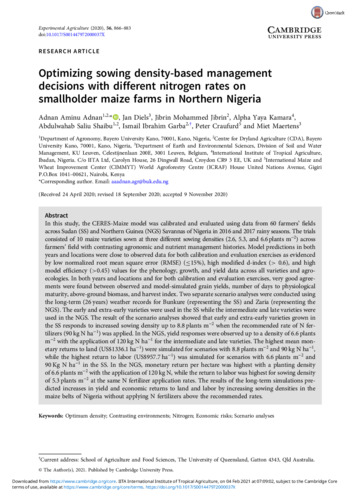Optimizing sowing density-based management decisions with different nitrogen rates on smallholder maize farms in northern Nigeria
Abstract
In this study, the CERES-Maize model was calibrated and evaluated using data from 60 farmers’ fields across Sudan (SS) and Northern Guinea (NGS) Savannas of Nigeria in 2016 and 2017 rainy seasons. The trials consisted of 10 maize varieties sown at three different sowing densities (2.6, 5.3, and 6.6 plants m−2) across farmers’ field with contrasting agronomic and nutrient management histories. Model predictions in both years and locations were close to observed data for both calibration and evaluation exercises as evidenced by low normalized root mean square error (RMSE) (≤15%), high modified d-index (> 0.6), and high model efficiency (>0.45) values for the phenology, growth, and yield data across all varieties and agro-ecologies. In both years and locations and for both calibration and evaluation exercises, very good agreements were found between observed and model-simulated grain yields, number of days to physiological maturity, above-ground biomass, and harvest index. Two separate scenario analyses were conducted using the long-term (26 years) weather records for Bunkure (representing the SS) and Zaria (representing the NGS). The early and extra-early varieties were used in the SS while the intermediate and late varieties were used in the NGS. The result of the scenario analyses showed that early and extra-early varieties grown in the SS responds to increased sowing density up to 8.8 plants m−2 when the recommended rate of N fertilizers (90 kg N ha−1) was applied. In the NGS, yield responses were observed up to a density of 6.6 plants m−2 with the application of 120 kg N ha−1 for the intermediate and late varieties. The highest mean monetary returns to land (US$1336.1 ha−1) were simulated for scenarios with 8.8 plants m−2 and 90 kg N ha−1, while the highest return to labor (US$957.7 ha−1) was simulated for scenarios with 6.6 plants m−2 and 90 Kg N ha−1 in the SS. In the NGS, monetary return per hectare was highest with a planting density of 6.6 plants m−2 with the application of 120 kg N, while the return to labor was highest for sowing density of 5.3 plants m−2 at the same N fertilizer application rates. The results of the long-term simulations predicted increases in yield and economic returns to land and labor by increasing sowing densities in the maize belts of Nigeria without applying N fertilizers above the recommended rates.

